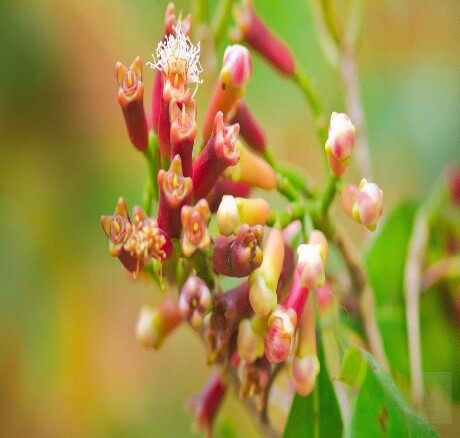Therapeutic constituents:
The clove contains 13 percent tannin (gallotannic acid). Oleanolic acid has been isolated from spent cloves (residue from the distillation of essential oil. Steam distillation of clove buds yields a colorless (14.23%) or pale-yellow oil, with the characteristic odor and taste of cloves. The oil darkens with age or on exposure and becomes reddish brown. The product obtained from whole buds contains a higher percentage (97%) of eugenol than that in oil distilled from crushed cloves (eugenol-94%). Water distillation yields oil of better quality and lowers specific gravity (eugenol 85-89 %) than that obtained by dry steam-distillation (eugenol, 91-95%). The two oils are distinguished as ‘opt’ and ‘strong’ oils; commercial oil is a mixture of both. The clove bud oil contains free eugenol, eugenol acetate (2-17%) and caryophyllene (chiefly a and ß-form) as its main constituents.Among the other constituents present, the most important is a methyl-n-amyl ketone, to which the oil owes its fresh and fruity aroma. Other substances present in traces are methyl salicylate, methyl benzoate, methyl alcohol, benzyl alcohol, furfuryl alcohol, furfural, a-methyl furfural, dimethyl furfural, b-pinene, methyl-n-heptyl ketone, methyl-n-amyl carbinol (2-heptanol), methyl-n-heptyl carbinol and vanillin.
The oil, obtained by solvent extraction of cloves, contains little or no caryophyllene but contains epoxydihydrocaryophyllene1.
The oil contains eugenone, eugenine, eugenitine and iso-eugenitol These substances are practically odourless2. It also contains sesquiterpenes, a-cubebene, a-copaene, g- and d-cadinene, b -caryophyllene, b-caryophyllene oxide, a-humulene, a-humulene epoxide besides eugenol.
The leaves yield an essential oil (3%) on steam distillation. It contains a-cubebene, a-copaene, b-caryophyllene, a-humulene, eugenol, isoeugenol acetate, eugenol acetate and farnesol. A neutral sesqueterpene fraction of an Indonesian sample contained a-cubenene, a-ylangene, a-copaene, b-bourbonene, b-caryophyllene, a-humulene, allo-aromadendrene, a-muurolene, zinziberine, d-cadinene, calamenene, a-calacorene, caryophyllene oxide, ledol, palustrol, d-cadinol, cubenol, calamenenol, cadalene, a-cadinol and humuladienone. Presence of ethyl acetate, ethanol, limonene, a& b-pinenes, p-cymene, 1,8-cineole, 4-methyl-3-pentenyl-3-furan, linalool, carvone, linalyl acetate, etc. are also reported in the clove leaf oil. The leaves also contain 3,4-dihydroxy phenethyl alcohol and the 3,4-dihydroxybenzoic acid having anti-inflammatory action3.
Eugenol is the principal chemical compound in Cloves, which renders the herb its fungicidal, anti-inflammatory and analgesic properties. Beta-caryophyllene, another component of clove oil, has exhibited topic anesthetic properties. Cloves are also an excellent source of manganese, vitamins C and K and dietary fiber. The herb is also rich in calcium and magnesium.
Pharmacology
The compounds of clove show significant activity as inducers of detoxifying enzyme-glutathione S-transferase in mouse liver and intestines. This ability is correlated with their activity in inhibiting the chemical carcinogenesis, and as anticancer agents. The methanolic extract of clove exhibits anti-tumor activity and showed remarkable induction of differentiation of myeloid leukemia (MI) cells into macrophage-like cells. Oleanolic acid and crategolic acid are the active principles of the extract4.
Toxicology
There is no adverse is reported on the use of this herb as a drug.
Clinical Studies
Clove forms an ingredient of pharmaceutical powder used in the treatment of gastronomic disorders caused due to alcohol consumption. A mixture of 120mg -cysteine, 300mg NaHCO3, 0.2ml Coptis rhizome tincture and 0.1ml clove tincture when administered orally before drinking is effective in treating a hangover. It is also an ingredient in anti-inflammatory and analgesic preparation containing cinnamaldehyde and skin irritants. The preparation accelerates blood circulation and does not cause pain at the application site5.
Key therapeutic benefits:
- Used in sustained release topical analgesic preparations and used in dentifrices for removal of stain in teeth, in root canal filling material, as a salivary stimulator in sublingual pharmaceutical compositions.
- buccal deodorant tapes and in dental bandages for protection to gingival tissue.
- Topical formulations for use in cryotherapy for treating circulatory diseases such as posttraumatic edema.
- The Eugenol and acetyl eugenol components of the oil inhibit arachidonate-adrenaline and collagen-induced platelet aggregation.
- Clove’s anesthetic and anti-inflammatory properties are helpful in alleviating joint aches and pains.
- The herb is a potent platelet inhibitor, preventing blood clots in the body. Studies have shown that Cloves stimulate insulin activity up to three times in the body, combating diabetes effectively.
Used in Orgado
References
- Guenther, IV, 412-13, 422, 427-28, 430-35; B.P.C., 1968, 189; Goldstein, J. sci. industr. Res., 1953, 12B, 281.
- Krishna & Badhwar, loc. cit2. Krishna & Badhwar, loc. cit.; Guenther, IV, 4273.
- Chem Abstr, 1990, 113, 29242; Gopalakrishnan al., Indian Perfum, 1988, 32, 229; Lawrence, Perfumer & Flavorist, 1991, 16(4), 494.
- Umehara, Chem Pharm Bull, 1992, 40, 401; Chem Abstr, 1993, 119, 70934; Mahmoud al., Int J Pharmacogn, 1992, 30, 815.
- Chem Abstr, 1991, 114, 254021; 1992, 116, 281766.
- Chem Abstr, 1992, 116, 154083; 1993, 119, 234079, 85713; 1991, 114, 115063; 1990, 113, 120609; Vilaplana al., Contact Dermatitis, 1991, 24, 225.


